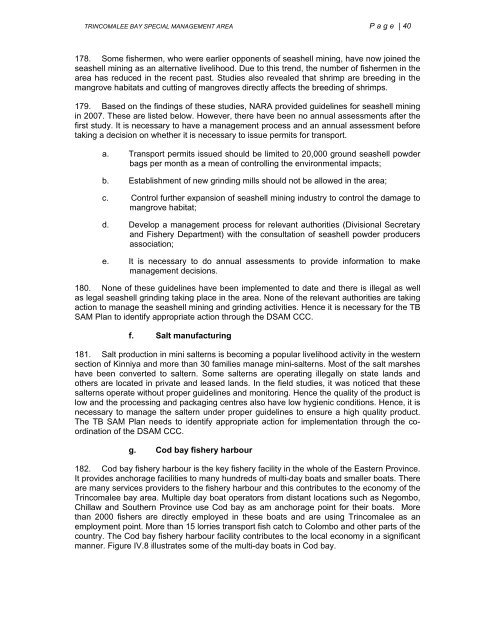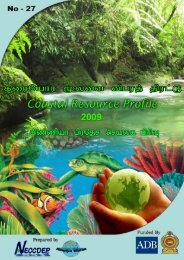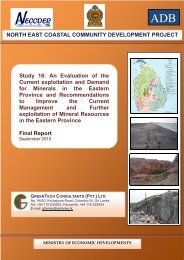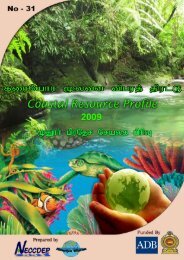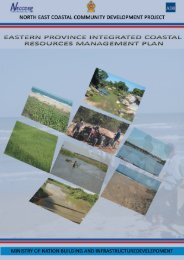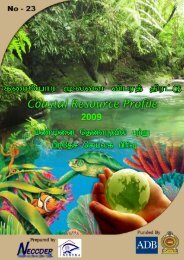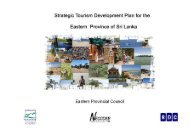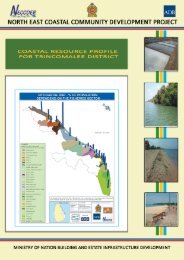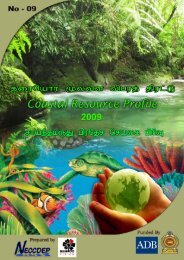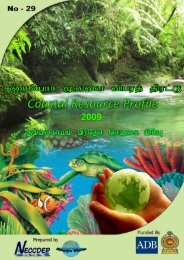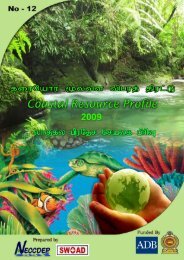Untitled - Neccdep.com
Untitled - Neccdep.com
Untitled - Neccdep.com
You also want an ePaper? Increase the reach of your titles
YUMPU automatically turns print PDFs into web optimized ePapers that Google loves.
TRINCOMALEE BAY SPECIAL MANAGEMENT AREA Page | 40<br />
178. Some fishermen, who were earlier opponents of seashell mining, have now joined the<br />
seashell mining as an alternative livelihood. Due to this trend, the number of fishermen in the<br />
area has reduced in the recent past. Studies also revealed that shrimp are breeding in the<br />
mangrove habitats and cutting of mangroves directly affects the breeding of shrimps.<br />
179. Based on the findings of these studies, NARA provided guidelines for seashell mining<br />
in 2007. These are listed below. However, there have been no annual assessments after the<br />
first study. It is necessary to have a management process and an annual assessment before<br />
taking a decision on whether it is necessary to issue permits for transport.<br />
a. Transport permits issued should be limited to 20,000 ground seashell powder<br />
bags per month as a mean of controlling the environmental impacts;<br />
b. Establishment of new grinding mills should not be allowed in the area;<br />
c. Control further expansion of seashell mining industry to control the damage to<br />
mangrove habitat;<br />
d. Develop a management process for relevant authorities (Divisional Secretary<br />
and Fishery Department) with the consultation of seashell powder producers<br />
association;<br />
e. It is necessary to do annual assessments to provide information to make<br />
management decisions.<br />
180. None of these guidelines have been implemented to date and there is illegal as well<br />
as legal seashell grinding taking place in the area. None of the relevant authorities are taking<br />
action to manage the seashell mining and grinding activities. Hence it is necessary for the TB<br />
SAM Plan to identify appropriate action through the DSAM CCC.<br />
f. Salt manufacturing<br />
181. Salt production in mini salterns is be<strong>com</strong>ing a popular livelihood activity in the western<br />
section of Kinniya and more than 30 families manage mini-salterns. Most of the salt marshes<br />
have been converted to saltern. Some salterns are operating illegally on state lands and<br />
others are located in private and leased lands. In the field studies, it was noticed that these<br />
salterns operate without proper guidelines and monitoring. Hence the quality of the product is<br />
low and the processing and packaging centres also have low hygienic conditions. Hence, it is<br />
necessary to manage the saltern under proper guidelines to ensure a high quality product.<br />
The TB SAM Plan needs to identify appropriate action for implementation through the coordination<br />
of the DSAM CCC.<br />
g. Cod bay fishery harbour<br />
182. Cod bay fishery harbour is the key fishery facility in the whole of the Eastern Province.<br />
It provides anchorage facilities to many hundreds of multi-day boats and smaller boats. There<br />
are many services providers to the fishery harbour and this contributes to the economy of the<br />
Trin<strong>com</strong>alee bay area. Multiple day boat operators from distant locations such as Negombo,<br />
Chillaw and Southern Province use Cod bay as am anchorage point for their boats. More<br />
than 2000 fishers are directly employed in these boats and are using Trin<strong>com</strong>alee as an<br />
employment point. More than 15 lorries transport fish catch to Colombo and other parts of the<br />
country. The Cod bay fishery harbour facility contributes to the local economy in a significant<br />
manner. Figure IV.8 illustrates some of the multi-day boats in Cod bay.


